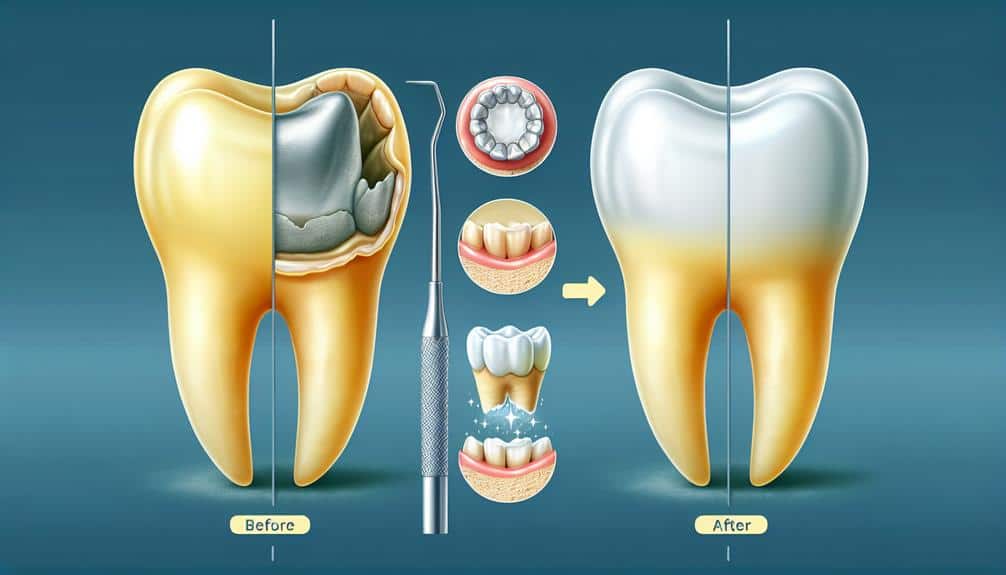When considering whitening treatments with crowns and fillings, it's important to prevent damage to your dental work. These treatments may not uniformly affect artificial restorations like your natural teeth. Bleaching agents can weaken the bond between materials, so consulting your dentist beforehand is essential. You should also explore alternative solutions such as veneers that won't compromise the integrity of your existing dental work. Remember, protecting your dental restorations during whitening is essential for best results.
Key Points
- Check restoration compatibility for even whitening results.
- Consult dentist to prevent damage to dental work.
- Address uneven color by replacing mismatched restorations.
- Manage sensitivity with desensitizing products and fluoride treatments.
- Seek professional guidance for personalized care and risk mitigation.
Risks of Bleaching Crowns and Fillings
When considering whitening treatments, it's important to be aware of the potential risks associated with bleaching crowns and fillings. Bleaching precautions are essential to prevent damage to dental restorations. One significant risk is the issue of restoration compatibility. Dental crowns and fillings don't whiten like natural teeth, which can result in uneven coloration after whitening procedures. It's essential to consult with your dentist to assess the compatibility of your restorations with whitening agents.
Moreover, material integrity is a key concern. Bleaching agents can affect the integrity of certain materials used in crowns and fillings, potentially leading to degradation or discoloration. Understanding the type of materials in your restorations is crucial to prevent any adverse effects caused by bleaching agents. If you have concerns about the impact of whitening treatments on your dental work, discuss whitening alternatives with your dentist to maintain the aesthetics and durability of your restorations.
Potential Damage to Dental Restorations
Bleaching treatments may pose risks to your dental restorations, potentially causing damage or alterations to the integrity and appearance of crowns and fillings. When considering teeth whitening procedures, it's crucial to understand how these treatments can impact existing dental work. Here's what you need to know:
- Avoiding Damage: Bleaching agents can weaken the bond between the dental restoration material and the tooth structure, leading to potential damage or even dislodgement.
- Color Matching: Whitening treatments may not affect the color of dental restorations in the same way as natural teeth, resulting in visible discrepancies that can affect the overall aesthetics of your smile.
- Professional Evaluation: Before undergoing any whitening procedure, consult your dentist to assess the current condition of your dental restorations and determine the best course of action to protect them.
- Alternative Solutions: In cases where whitening treatments pose a risk to existing dental work, your dentist may recommend alternative solutions such as veneers or bonding to achieve a whiter smile without compromising the integrity of your restorations.
Uneven Color Results on Teeth
To achieve consistent and uniform color results on your teeth, it's important to take into account the potential impact of whitening treatments on existing dental restorations. When considering teeth whitening, especially if you have crowns or fillings, color matching can pose challenges. Natural teeth may respond differently to whitening agents compared to artificial dental restorations, leading to uneven color results. This can result in a mismatch between your natural teeth and existing dental work, which can be aesthetically displeasing.
In cases where uneven color results occur due to existing dental restorations, there are cosmetic alternatives available to address this issue. One option is to replace the mismatched crowns or fillings with new restorations that match the newly whitened natural teeth. Another alternative involves exploring additional cosmetic procedures such as veneers to achieve a more uniform and harmonious smile.
It is essential to consult with a dentist experienced in cosmetic dentistry to determine the best course of action for achieving the desired color results while considering the impact on existing dental work.
Risk of Sensitivity and Discomfort
Considering the potential risks associated with teeth whitening treatments, it's essential to be aware of the likelihood of experiencing sensitivity and discomfort during and after the procedure. Here are some key points to help you manage and prevent sensitivity and discomfort:
- Use desensitizing toothpaste: Prior to the whitening treatment, switch to a desensitizing toothpaste containing potassium nitrate to help reduce sensitivity.
- Limit whitening sessions: Avoid overdoing it with whitening sessions to prevent excessive sensitivity. Follow the instructions provided by your dentist or the whitening product.
- Consider fluoride treatments: Fluoride can help strengthen your teeth and reduce sensitivity. Consult your dentist about fluoride treatments before or after whitening.
- Discuss pain management options: If you experience significant discomfort during or after the whitening procedure, consult your dental professional for pain management strategies tailored to your needs.
Consultation With a Dental Professional
For comprehensive guidance on teeth whitening risks and the best approach for your specific situation, seeking a consultation with a dental professional is essential. A dental professional can provide you with expert guidance tailored to your individual needs and oral health status. During the consultation, the dentist will evaluate your current dental health, including the presence of any crowns or fillings that may impact the whitening process. They'll also discuss the potential risks associated with whitening treatments in relation to your existing dental work.
Furthermore, a dental professional can present you with various treatment options based on your oral health conditions and desired outcomes. They can recommend safe and effective whitening methods that are suitable for your specific situation, taking into consideration any previous dental work you may have undergone. Consulting with a dental professional ensures that you receive personalized care and minimizes the risks associated with whitening treatments, especially when crowns and fillings are involved.
Frequently Asked Questions
Can Whitening Treatments Cause My Crowns and Fillings to Become Discolored Over Time?
Whitening treatments may lead to discoloration of crowns and fillings over time. To maintain their longevity, consider alternative options like veneers. Regular maintenance tips include gentle brushing and avoiding staining foods to prevent premature discoloration.
How Long Do Dental Restorations Typically Last After Undergoing a Whitening Treatment?
You may feel like your dental restorations will last forever after a whitening treatment, but realistically, longevity varies. Proper maintenance, like professional advice and precautions, can help them endure. Always seek professional guidance for accurate expectations.
Are There Any Alternative Options for Whitening Teeth if I Have Crowns or Fillings?
If you have crowns or fillings, alternative options like bonding or veneers can effectively whiten your teeth. These solutions offer long-term maintenance and prevent damage to existing dental restorations. Consult your dentist for the best choice.
Is It Possible for Whitening Treatments to Cause Uneven Color Results on Natural Teeth Next to Crowns and Fillings?
When whitening treatments hit, uneven color on naturals near crowns or fillings can be a showstopper. To nail that color matching, seek pro advice. Precautionary measures are key for maintenance. Stay in the know!
How Can I Minimize the Risk of Sensitivity and Discomfort When Whitening Teeth With Dental Restorations?
To minimize sensitivity and discomfort when whitening with dental restorations, start by using a toothpaste for sensitive teeth weeks before treatment. Ask your dentist about restoration compatibility and custom trays for even whitening. Prioritize tooth health and pain management.




